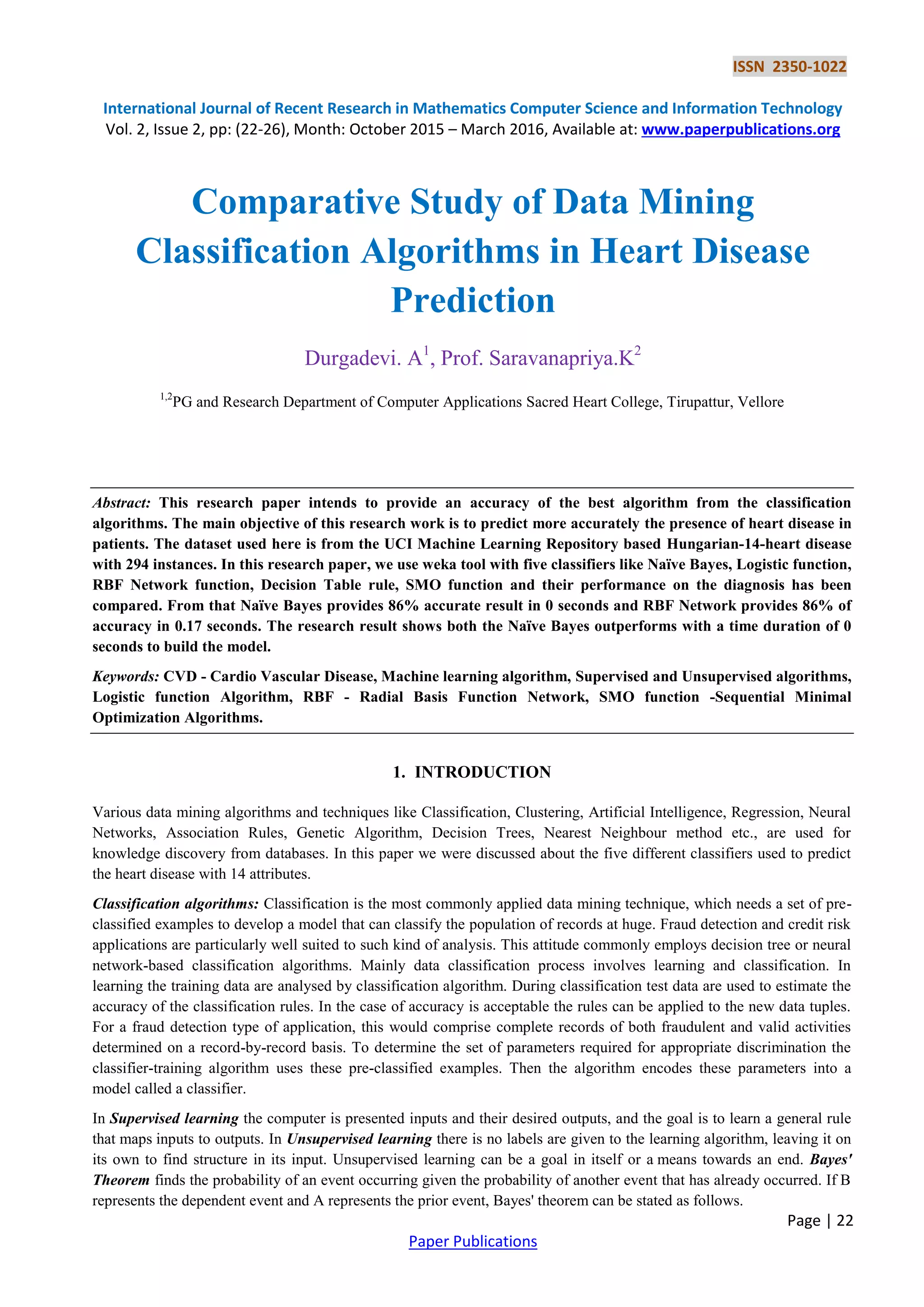This research paper compares classification algorithms for heart disease prediction using the Hungarian-14 heart disease dataset, identifying Naïve Bayes and RBF Network as the most accurate, each achieving 86% accuracy. Utilizing the WEKA tool, the study evaluates performance in terms of accuracy and processing time of several algorithms including logistic regression and decision tables. The findings indicate Naïve Bayes outperforms the others with a 0-second model building time, emphasizing the potential of combining classification techniques for improved results in heart disease detection.



![ISSN 2350-1022 International Journal of Recent Research in Mathematics Computer Science and Information Technology Vol. 2, Issue 2, pp: (22-26), Month: October 2015 – March 2016, Available at: www.paperpublications.org Page | 25 Paper Publications Figure 3.3 Screen shot of report viewer (CVD) In figure 3.1 and 3.2 shows the naïve bayes and the RBFNetwork function results.Both the naïve bayes and the RBFNetwork function will provides the 86% of accuracy. The Naïve Bayes algorithm provides 0.7009 kappa statistics and the RBFNetwork function provides 0.6983 kappa statistics. The Naïve Bayes theorem provides the highest kappa statistics. Figure 3.3 shows the CVD report. 4. CONCLUSION AND FUTURE WORK Naïve Bayes, Logistic function, RBF Network, Decision Table, SMO function algorithms are used for testing and the testing results show that the Naïve Bayes algorithm outperforms with 86% accuracy in 0 seconds. A comparative study is applied to determine the most effective techniques that are capable for the detection of heart valve disease with a high accuracy. To implement the combination of classification techniques to improve the performance of the algorithms. REFERENCES [1] Anita Devi, Abhishek Misal, “A Survey on Classifiers Used in Heart Valve Disease Detection” ,International Journal of Advanced Research in Electrical, Electronics and Instrumentation Engineering Vol. 2, Issue 1, January 2013 [2] K.R. Lakshmi , M.Veera Krishna and S.PremKumar,“Performance comparison of Data Mining Techniques for Predicting of Heart Disease Survivability”, International Journal of Scientific and Research Publications, Volume 3, Issue 6, June 2013 1 ISSN 2250-3153 [3] B.Venkatalakshmi, M.V Shivsankar ,“Heart Disease Diagnosis Using Predictive Data mining” International Journal of Innovative Research in Science, Engineering and Technology Volume 3, Special Issue 3, March 2014 International Conference on Innovations in Engineering and Technology (ICIET’14)](https://image.slidesharecdn.com/comparativestudyofdatamining-501-170106053446/75/Comparative-Study-of-Data-Mining-Classification-Algorithms-in-Heart-Disease-Prediction-4-2048.jpg)
![ISSN 2350-1022 International Journal of Recent Research in Mathematics Computer Science and Information Technology Vol. 2, Issue 2, pp: (22-26), Month: October 2015 – March 2016, Available at: www.paperpublications.org Page | 26 Paper Publications [4] Sona Baby, Ariya T.K, “A survey paper of data mining in medical diagnosis”, international journal of research in IJRCCT computer and communication technology. [5] K.Srinivas, Dr. G. Raghavendra Rao and and Dr. A. Govardhan, “survey on prediction of heart morbidity using data mining techniques”,International Journal of Data Mining & Knowledge Management Process (IJDKP) Vol.1, No.3, May 2011 [6] Beant Kaur, Williamjeet Singh,“ Review on Heart Disease Prediction System using Data Mining Techniques” International Journal on Recent and Innovation Trends in Computing and Communication ISSN: 2321-8169 Volume: 2 Issue: 10 [7] Prof. Gondkar Mayura D.1, Prof. Pawar Suvarna E, “ A Survey On Data Mining Techniques To Find Out Type Of Heart Attack”, IOSR Journal of Computer Engineering (IOSR-JCE) e-ISSN: 2278-0661, p-ISSN: 2278- 8727Volume 16, Issue 1, Ver. V (Jan. 2014), PP 01-05 [8] Vikas Chaurasia,etal,Carib.j.SciTech, “Early Prediction of Heart Diseases Using Data Mining Techniques” , ,2013,Vol.1,208-217 [9] Aqueel Ahmed, Shaikh Abdul Hannan, “Data Mining Techniques to Find Out Heart Diseases: An Overview”, International Journal of Innovative Technology and Exploring Engineering (IJITEE) ISSN: 2278-3075, Volume-1, Issue-4, September 2012 [10] Dr.Hari Ganesh S and Gajenthiran M, “Comparative study of Data Mining Approaches for prediction Heart Diseases”, IOSR Journal of Engineering (IOSRJEN) www.iosrjen.org ISSN (e): 2250-3021, ISSN (p): 2278-8719 Vol. 04, Issue 07 (July. 2014), ||V3|| PP 36-39 [11] Devendra Shah, Ketan Kadam, Shubham Shinde , Akash Doiphode, “Heart Disease Prediction: A Data Mining Aspect”, International Journal of Engineering Technology, Management and Applied Sciences [12] Zarna Parekh, Avaniba Parmar, “Survey Paper on Early Diagnosis Ofcardio-Vascular Disease Using Data Mining And Neural Network”, IJSRD - International Journal for Scientific Research & Development| Vol. 2, Issue 10, 2014 ISSN (online): 2321-0613 [13] Jyoti Soni, Ujma Ansari, Dipesh Sharma and Sunita Soni, “Predictive Data Mining for Medical Diagnosis: An Overview of Heart Disease Prediction”, International Journal of Computer Applications (0975 – 8887) Volume 17– No.8, March 2011 [14] Vikas Chaurasia and Saurabh Pal, “Data Mining Approach to Detect Heart Dieses”, International Journal of Advanced Computer Science and Information Technology (IJACSIT) Vol. 2, No. 4, 2013, Page: 56-66, ISSN: 2296- 1739.](https://image.slidesharecdn.com/comparativestudyofdatamining-501-170106053446/75/Comparative-Study-of-Data-Mining-Classification-Algorithms-in-Heart-Disease-Prediction-5-2048.jpg)